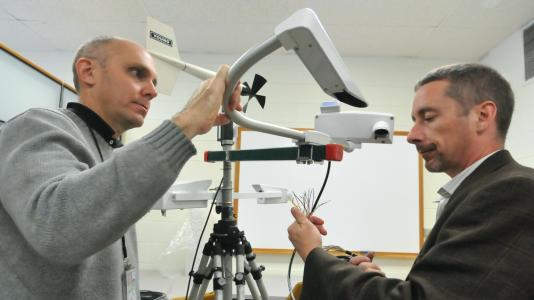
They know, too, that aerosols, those tiny particles or liquids suspended in air, also affect the global thermostat, but they aren’t sure by how much.
Funding from the American Recovery and Reinvestment Act (ARRA)—announced earlier this year—will help bring scientists closer to answering these and other critical climate questions.
The U.S. Department of Energy’s Office of Science provided $60 million in ARRA funding for climate research to the Atmospheric Radiation Measurement (ARM) Climate Research Facility, a DOE national user facility that has been operating climate observing sites around the world for nearly two decades. These sites help scientists study clouds and their influence on the sun’s radiant energy, which heats our planet.
ARM targets regions for which scientists have little climactic data. The information it has collected has had a tremendous impact on improving climate models used to forecast the timing, location, and magnitude of climate change. Detailed information such as this will help bring scientists closer to consensus about the scope and pace of climate change.
“The ARRA funding has provided an unprecedented opportunity for ARM to expand its reach,” said Doug Sisterson, meteorologist and operations manager of the ARM Climate Research Facility. “This new capability will allow scientists to dramatically improve climate model forecasts.”
The money will be used to purchase 143 climate measurement tools, including dual-frequency scanning radars that allow scientists to understand cloud composition, the movement of particles within clouds and their effect on the sun’s radiant energy.
It will also fund the installation of precipitation radars to the ARM sites to measure the life cycle of clouds, and it will pay for new equipment to help scientists understand the chemical composition of aerosols, which is considered an important variable in climate change.
Argonne National Laboratory is responsible for spending $4.6 million of the ARRA funding. The bulk of the money will provide infrastructure support for cloud and precipitation radars in the Southern Great Plains, a task assigned to Argonne’s own Brad Orr, an atmospheric scientist.
The funding will also help purchase and install specialized equipment at all ARM sites, an effort lead by Argonne meteorologist David Cook. This new equipment will allow scientists to better understand heat loss at the Earth’s surface.
The remainder of the $4.6 million will help in the collection, processing and dissemination of the mass amounts of data to be collected from all of the ARM sites. Richard Eagan, a systems engineer at Argonne, will oversee this crucial element of the program.
All high-quality data collected by the ARM climate research facility is made freely available to anyone worldwide, usually with 24 to 48 hours of collection. Data from the new instrumentation is expected to be available in the fall of 2010 via the ARM Data Archive at www.archive.arm.gov/armlogin/login.jsp.
As for ARM itself, the program got its start in 1989 with funding from the DOE Office of Science’s Office of Biological and Environmental Research.
Scientists chose three diverse climatic regions for their fixed sites—one in the Southern Great Plains in Oklahoma and Kansas, another in the North Slope of Alaska and a third in the Tropical Western Pacific.
ARM also has mobile facilities; the first was deployed in 2005, and a second is under development and scheduled for deployment in 2010.
The program also boasts an aerial facility that provides airborne measurements.
Nine DOE national laboratories share the responsibility of managing and operating the ARM Climate Research Facility. Argonne has a leading role and is responsible for ARM Operations, including all fixed sites, mobile facilities, instrument systems and repairs, data processing, education outreach and field safety oversight among other responsibilities. Argonne is also charged with managing the Southern Great Plains site, developing and operating the second mobile facility and maintaining all data collection and dissemination for all ARM sites.
For more on the ACRF, please go to www.arm.gov.
